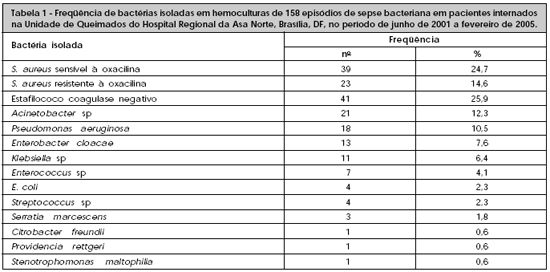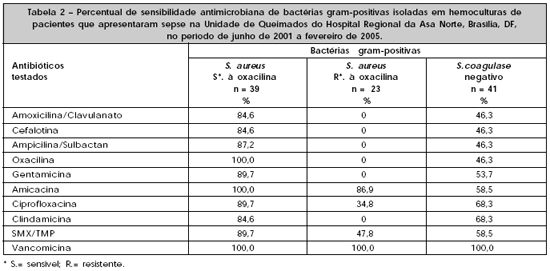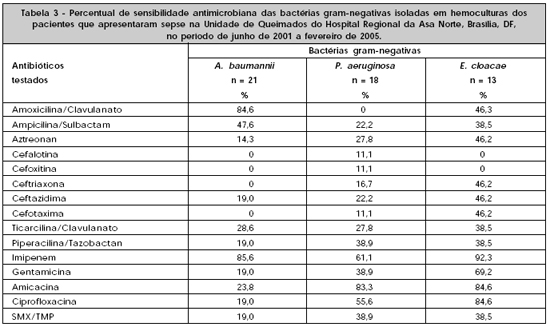

Original Article - Year 2005 - Volume 20 -
Sepsis in burn patient: microbiological and antimicrobial susceptibility study
Sepse no Paciente Queimado: Estudo Microbiológico e da Sensibilidade Antimicrobiana
ABSTRACT
The study was done between burn patients with sepsis, which were treated as in-patients at the Burn Unit of Hospital Regional da Asa Norte, Brasília, Brazil, from June of 2001 to February of 2005. One hundred thirty and nine (15.5%) patients had sepsis amongst 895 cases admitted to the Burn Unit during the period of study. They had single or less then/or four sepsis episodes amounting to a total of 171. Seventy-eight (56.1%) were males and the mean age was 21 years (range one year to 89 years). The total body surface area burned varied from seven to 88% with a mean of 34.0%. The primary foci of sepsis episodes were the burn wound (45.6%), the lung (10.5%), the intravascular devices (8.8%) and unknown source (35.1%). The most common bacteria isolated from the blood culture of the cases of sepsis were Staphylococcus sp. (65.2%), Acinetobacter sp. (12.3%), Pseudomonas aeruginosa (10.5%) and Enterobacter cloacae (7.6%). Eighty and seven (62.6%) patients had their first septicaemic episode either earlier or by one week postburn. S. aureus were isolated from 62 episodes of sepsis and amongst these, 19 (37.1%) were oxacillin resistant. All Staphylococcus were sensitive to vancomycin. In conclusion, the knowledge about the most prevalent bacteria and the antimicrobial sensitivity profiles would enable early treatment of imminent septic episodes with proper empirical systemic antibiotics, without waiting for culture results, thus improving the morbidity and mortality of burned patients with sepsis.
Keywords: Burns. Burn units. Sepsis. Cross infection
RESUMO
O estudo compreendeu os pacientes internados na Unidade de Queimados do Hospital Regional da Asa Norte, Brasília-DF, no período de 1º de junho de 2001 a 1º de fevereiro de 2005. Cento trinta e nove (15,5%) pacientes tiveram sepse, de um total de 895 queimados. Cada paciente teve um ou, no máximo, quatro episódios de sepse durante a internação, totalizando 171 episódios. Setenta e oito (56,1%) eram homens e a idade média foi 21 anos (variação de 1 a 89 anos). A superfície corporal queimada variou de 7 a 88%, com uma média de 34,0%. Os sítios de origem dos episódios de sepse foram: a ferida queimada (45,6%), o pulmão (10,5%), o cateter vascular (8,8%) e origem desconhecida ou não determinada (35,1%). As principais bactérias causadoras de sepse foram Staphylococcus sp. (65,2%), Acinetobacter sp. (12,3%), Pseudomonas aeruginosa (10,5%) e Enterobacter cloacae (7,6%). Oitenta e sete (62,6%) pacientes tiveram o primeiro episódio de sepse na primeira semana de internação. Em 62 episódios com isolamento de S. aureus, houve resistência à oxacilina em 37,1%. Todos estafilococos se mostraram sensíveis à vancomicina. Em conclusão, o conhecimento das bactérias prevalentes e da sensibilidade antimicrobiana facilitará a elaboração de protocolos de atendimento, esquemas antimicrobianos e medidas terapêuticas mais eficazes, contribuindo para diminuir a morbidade e a letalidade dos pacientes queimados, com sepse.
Palavras-chave: Queimaduras. Unidades de queimados. Sepse. Infecção hospitalar
A sepse ocorre quando o equilíbrio entre o hospedeiro e os microorganismos é rompido. Vários fatores favorecem a sepse no paciente queimado: a destruição da barreira epitelial, a imunossupressão, a translocação bacteriana gastrointestinal e a internação prolongada1,2. Atualmente, apesar do desenvolvimento de novos agentes antimicrobianos, dos avanços no suporte nutricional e das técnicas cirúrgicas, a sepse continua representando uma das principais causas de óbito do paciente queimado3.
O objetivo desse estudo foi investigar os aspectos microbiológicos dos pacientes internados da Unidade de Queimados do Hospital Regional da Asa Norte (HRAN) de Brasília que desenvolveram sepse, no intuito de elaborar medidas terapêuticas mais adequadas.
MÉTODO
O estudo compreendeu os pacientes tratados em regime de internação hospitalar na Unidade de Queimados do HRAN, Brasília-DF, no período de 1º de junho de 2001 a 1º de fevereiro de 2005. Os critérios de internação na Unidade de Queimados foram descritos anteriormente1.
Os pacientes considerados casos de sepse foram aqueles que preencheram os seguintes critérios: quadro clínico compatível com sepse e hemocultura positiva. As manifestações clínicas da sepse incluíam dois ou mais sinais da síndrome da resposta inflamatória sistêmica (hipertermia >38ºC ou hipotermia < 36ºC; leucocitose >12.000 células/mm3 ou leucopenia < 4.000 células/mm3; taquicardia; taquipnéia) associados ou não a disfunções orgânicas (acidose lática, hipotensão grave, oligúria, trombocitopenia, azotemia ou deterioração do estado mental)4.
O sangue para cultivo foi coletado por punção venosa, com técnica asséptica, utilizando material estéril e meios de cultura específicos padronizados para leitura no Bact Alert 120® e no Microsacan Walkway 96®. Além disso, foi analisada a evolução clínica dos pacientes na enfermaria; assim como, os resultados das hemoculturas, das uroculturas, da cultura de material coletado na ferida queimada, de secreção pulmonar e do cateter vascular, interessando o agente isolado, a sensibilidade antimicrobiana e a investigação da possível origem da sepse. O foco de origem da sepse foi considerado aquele onde se isolou o microorganismo da mesma espécie e do mesmo padrão de sensibilidade antimicrobiana da hemocultura.
O estudo foi aprovado pelo Comitê de Ética em Pesquisa da Secretaria de Saúde do Distrito Federal (Parecer 088/2003).
RESULTADOS
A taxa de sepse dos pacientes internados na Unidade de Queimados foi 15,5%. Eles apresentaram um ou, no máximo, quatro episódios de sepse durante a internação, totalizando 171 episódios. A idade média foi 21 anos (variação de 1 a 89 anos). A maioria dos pacientes era do sexo masculino homens (56,1%) e procedentes de fora do Distrito Federal (51,1%), principalmente de Goiás e de Minas Gerais. A superfície corporal queimada variou de 7 a 88%, com uma média de 34%. A chama aberta foi a causa predominante das queimaduras, levando a 77,0% dos casos de sepse, seguidos por escaldamento (17,9%) e eletricidade (5,1%). Em 20,1% dos pacientes estava presente a tentativa de auto-extermínio.
Cento e dezesseis pacientes tiveram um único episódio de sepse, e 23 tiveram dois ou mais episódios. Em 62,6% dos pacientes, o primeiro episódio de sepse ocorreu na primeira semana de internação, em 24,5%, na segunda e em 12,9%, na terceira semana ou após.
Os 139 pacientes estudados apresentaram um total de 171 episódios de sepse, 158 por bactérias e 13 devido a Candida sp. Dos 158 episódios de sepse bacteriana, 57,6% foram devido a gram-positivos, 34,8%, a gram-negativos e 7,6%, aos dois grupos de bactérias.
Os sítios de origem dos 171 episódios de sepse foram: a ferida queimada (45,6%), o pulmão (10,5%), o cateter vascular (8,8%) e de origem desconhecida ou não determinada (35,1%). As principais bactérias envolvidas nos episódios de sepse em queimados foram Staphylococcus sp. (65,2%), Acinetobacter sp. (12,3%) e Pseudomonas aeruginosa (10,5%) - Tabela 1.

Dos 62 episódios com isolamento de S. aureus, a bactéria se mostrou resistente à oxacilina em 23 (37,1%) casos. Dos 41 episódios com estafilococo coagulase negativo, 22 (53,7%) casos apresentaram resistência à oxacilina. Todos estafilococos se mostraram sensíveis à vancomicina - Tabela 2.

Quanto à sensibilidade antimicrobiana das bactérias gram-negativas, Acinetobacter sp. se mostrou sensível ao imipenem em 85,6% dos episódios e com baixa sensibilidade aos outros antibióticos testados. E. cloacae apresentou sensibilidade acima de 80,0% ao imipenem, à amicacina e à ciprofloxacina. P. aeruginosa apresentou sinais de resistência aos carbapenêmicos, aos aminoglicosídeos e às quinolonas (Tabela 3).

As manifestações clínicas dos casos de sepse foram febre (94,2%), dispnéia (51,5%), hipotensão arterial (39,8%), oligúria (29,2%), deterioração mental (22,8%), icterícia (15,2%), anasarca (12,2%) e sangramentos (8,8%).
As alterações laboratoriais dos casos de sepse foram hemoglobina < 10 g/dl (67,3%), leucócitos >12.000 células/ml (64,3%), albumina sérica < 2,5 g/dl (45,6%), plaquetas < 100.000/ ml (33,9%), níveis de bilirrubina >2 mg/dl (15,2%) e creatinina sérica >2 mg/dl (11,1%).
Vinte e seis (18,7%) pacientes morreram durante o estudo, com uma média de idade de 31 anos (1 a 93 anos). A superfície corporal queimada variou de 12 a 88% (média 44,5%). Houve 39 episódios de sepse nesses 26 pacientes, da internação no hospital até a morte, sendo isolados gram-negativos em 20 (51,3%) episódios, gram-positivos em 14 (35,9%) e fungos em cinco (12,8%).
DISCUSSÃO
Na queimadura, a progressão de simples colonização para infecção invasiva e sepse é dependente de fatores relacionados ao paciente, ao microrganismo e a fatores iatrogênicos2. A sepse é a segunda complicação infecciosa mais comum no queimado5.
A prevalência de sepse nesse estudo está acima dos 7,2% encontrada por Bang et al.6. Entretanto, a taxa de letalidade permaneceu em níveis similares a outros estudos7,8. Cerca de 40% dos casos de sepse ocorreram em crianças abaixo de 11 anos, geralmente envolvidas em acidentes domésticos que levaram às queimaduras. A principal causa da queimadura foi a chama aberta; as queimaduras por fogo são geralmente mais extensas e profundas, aumentando o risco de sepse. A primeira semana de internação foi crítica para os queimados, quando a maioria dos pacientes apresentou o primeiro episódio de sepse.
O sítio da queimadura foi a principal porta de entrada para sepse no paciente queimado6,7. Porém, em uma grande porcentagem dos casos, a origem não foi detectada. Isso se deveu provavelmente à dificuldade de se determinar constantemente a flora predominante na pele, na árvore traqueobrônquica, nos cateteres vasculares e nas sondas. Outro sítio de origem da sepse foi o trato respiratório, pois o grande queimado apresenta maior risco de infecções respiratórias devido à imobilidade, à tosse ineficaz pelo consumo muscular, ao uso de antiácidos e aos procedimentos de anestesia geral a que é submetido nos freqüentes procedimentos cirúrgicos8.
A freqüência maior de sepse foi por gram-positivos, destacando- se S. aureus e estafilococos coagulase negativos, similar aos achados de Bang et al.6 e de Song et al.9. Os fatores predisponentes são a internação prolongada e o uso de antibióticos sistêmicos, e a transmissão é geralmente realizada de um paciente para outro, através da colonização das mãos ou das narinas dos profissionais de saúde, do ambiente, das soluções de sulfadiazina de prata ou dos tanques de hidroterapia10. O uso inadequado ou exagerado da vancomicina nas Unidades de Queimados pode favorecer o surgimento de resistência de S. aureus a esse antimicrobiano11. Todos estafilococos se mostraram sensíveis à vancomicina, que representa o antibiótico de escolha no tratamento da sepse por essas bactérias.
P. aeruginosa foi a quarta causa de sepse em queimados, diferente de outra análise que aponta como a principal causa de sepse5. A resistência de P. aeruginosa aos carbapenêmicos, à amicacina e às quinolonas foi observada, destacando-se resistência de quase 80% à ceftazidima, que é uma cefalosporina de ação específica anti-Pseudomona; porém, possivelmente, pelo uso rotineiro na Unidade de Queimados, apresentou-se com poder de ação diminuído. Os carbapenêmicos são a melhor opção para o tratamento dessas infecções12.
Acinetobacter sp, a terceira bactéria mais isolada, está progressivamente sendo responsabilizada por infecções hospitalares, necessita de poucos nutrientes e é altamente resistente aos antimicrobianos. O imipenem é o agente mais efetivo contra Acinetobacter sp. e relatos mostram uma resistência acima de 50% à piperacilina/tazobactan, à ticarcilina/clavulanato, às cefalosporinas, aos aminoglicosídeos e quinolonas11,13.
O enterococo causou apenas 4,1% das sepses, mas pode transmitir resistência à vancomicina para os estafilococos, muito prevalentes em queimaduras14.
O conhecimento do quadro clínico e laboratorial, das bactérias prevalentes e da sensibilidade antimicrobiana, facilitará a elaboração de protocolos de atendimento, esquemas antimicrobianos e medidas terapêuticas mais eficazes, contribuindo para diminuir a morbidade e a letalidade dos pacientes queimados, com sepse.
REFERÊNCIAS BIBLIOGRÁFICAS
1. Macedo JLS, Rosa SC. Estudo epidemiológico dos pacientes internados na Unidade de Queimados: Hospital Regional da Asa Norte, Brasília, 1992-1997. Brasília Med. 2000;37:87-92.
2. Macedo JLS. Imunodepressão no queimado: patogênese e fator de risco para sepse. Rev Bras Queimaduras. 2003;3:26-35.
3. Nguyen TT, Gilpin DA, Meyer NA, Herndon DN. Current treatment of severely burned patients. Ann Surg. 1996;223(1):14-25.
4. Bone RC, Balk RA, Cerra FB, Dellinger RP, Fein AM, Knaus WA et al. Definition for sepsis and organ failure and guidelines for the use of innovative therapies in sepsis. The ACCP/SCCM Consensus Conference Committee. American College of Chest Physicians/Society of Critical Care Medicine. Chest. 1992;101(6):1644-55.
5. Oncul O, Yuksel F, Altunay H, Açikel C, Çeliköz B, Çavuslu S. The evaluation of nosocomial infection during 1-yearperiod in the burn unit of a training hospital in Istanbul, Turkey. Burns. 2002;28(8):738-44.
6. Bang RL, Sharma PN, Sanyal SC, Al Najjadah I. Septicaemia after burn injury: a comparative study. Burns. 2002;28(8):746-51.
7. Macedo JL, Rosa SC, Castro C. Sepsis in burned patients. Rev Soc Bras Med Trop. 2003;36(6):647-52.
8. Romero-Vivas J, Rubio M, Fernandez C, Picazzo JJ. Mortality associated with nosocomial bacteremia due to methicilin-resistant Staphylococcus aureus. Clin Infect Dis.1995;21(6):1417-23.
9. Song W, Lee KM, Kang HJ, Shin DH, Kim DK. Microbiologic aspects of predominant bacteria isolated from the burn patients in Korea. Burns. 2001;27(2):136-9.
10. Embil JM, McLeod JA, Al-Barrak AM, Thompson GM, Aoki FY, Witwicki EJ et al. An outbreak of methicillin resistant Staphylococcus aureus on a burn unit: potential role of contaminated hydrotherapy equipment. Burns. 2001; 27(7):681-8.
11. McManus AT, Goodwin CW, Pruitt Jr. BA. Observations on the risk of resistance with the extended use of vancomycin. Arch Surg. 1998;133(11):1207-11.
12. Mokaddas EM, Sanyal SC. Resistance patterns of Pseudomonas aeruginosa to carbapenems and piperacillin/tazobactam. J Chemother. 1999;11(2):93-6.
13. Cisneros JM, Reyes MJ, Pachon J, Becerril B, Caballero FJ, García-Garmendía JL et al. Bacteremia due to Acinetobacter baumannii: epidemiology, clinical findings and prognostic features. Clin Infect Dis. 1996;22(6):1026-32.
14. Still J, Law E, Friedman B, Fuhrman S, Newton T. Vancomycin-resistant organisms on a burn unit. Southern Med J. 2001;94(8):810-2.
I. Membro Titular da Sociedade Brasileira de Cirurgia Plástica. Mestre em Medicina pela Universidade de Brasília (UnB), Brasília, DF.
II. Acadêmica de Medicina da Universidade Católica de Brasília, Brasília, DF.
III. Professor Adjunto de Doenças Infecciosas da Faculdade de Medicina da UnB, Brasília, DF.
Correspondência para:
Dr. Jefferson Lessa S. de Macedo
SQS 213 Bloco H, apto 104
Brasília, DF - CEP: 70292-080
Tel: 0xx61 327-8415
Trabalho realizado na Unidade de Queimados do Hospital Regional da Asa Norte, Brasília, DF.
Artigo recebido: 05/08/2005
Artigo aprovado: 02/09/2005


 Read in Portuguese
Read in Portuguese
 Read in English
Read in English
 PDF PT
PDF PT
 Print
Print
 Send this article by email
Send this article by email
 How to Cite
How to Cite
 Mendeley
Mendeley
 Pocket
Pocket
 Twitter
Twitter